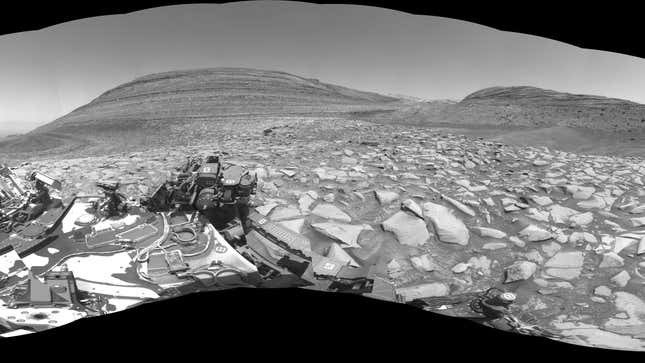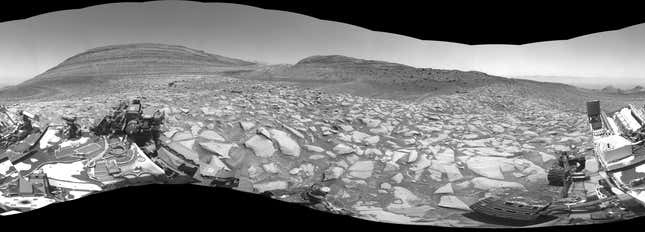
Curiosity has been exploring Mars for nearly 12 years, and the diligent robot has just made it to its next stop. As soon as it arrived at Gediz Vallis, NASA’s Mars rover captured the rocky terrain of the winding channel that may have been carved by an ancient river that once flowed on Mars.
NASA recently revealed the gorgeous black and white, 360-degree panorama of Gediz Vallis, which was captured by the Curiosity rover on February 3 using one of its navigation cameras. The Martian rover will spend months exploring the channel, gathering clues about Mars’ potentially warmer, water-filled past.

The panorama shows the “dark sand that fills one side of the channel and a debris pile rising just behind the sand,” NASA wrote. “In the opposite direction is the steep slope that Curiosity climbed to reach this area.”
Scientists believe Mars may have had bodies of water flowing across its surface billions of years ago. The Gediz Vallis channel is carved into the underlying bedrock, and is filled with boulders and other debris. The team behind the Curiosity mission are looking to gather clues as to how the channel formed, whether it was carved by an ancient river, wind, or dry avalanches.
Learning about Gediz Vallis not only provides a look into Mars’ ancient history and the possibility of it being once habitable, but could also suggest that water on Mars may have come and gone in phases, as opposed to gradually disappearing as the planet became more dry.
The Curiosity rover has been trekking the foothills of Mount Sharp since 2014, exploring layers in the lower part of the Martian mountain which formed over millions of years amid a changing climate on Mars. A lower part of those foothills included a layer rich in clay minerals, which formed as a result of a lot of water interacting with rock. As Curiosity moves across Gediz Vallis, this region of Mars is enriched with sulfates, or salty minerals that often form as water evaporates. That means the Gediz Vallis channel formed long after Mount Sharp. The debris and boulders within the channel may have also came from high up on the mountain, according to NASA.
“If the channel or the debris pile were formed by liquid water, that’s really interesting,” Ashwin Vasavada, Curiosity’s project scientist at NASA’s Jet Propulsion Laboratory, said in a statement. “It would mean that fairly late in the story of Mount Sharp – after a long dry period – water came back, and in a big way.”